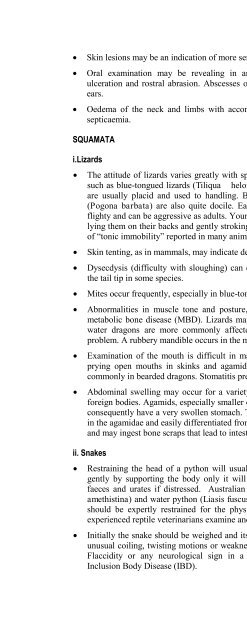Handling and Nursing Reptiles - Australian Veterinary Association
Handling and Nursing Reptiles - Australian Veterinary Association
Handling and Nursing Reptiles - Australian Veterinary Association
You also want an ePaper? Increase the reach of your titles
YUMPU automatically turns print PDFs into web optimized ePapers that Google loves.
Skin lesions may be an indication of more serious disease.<br />
Oral examination may be revealing in an otherwise healthy animal. Look for crusts,<br />
ulceration <strong>and</strong> rostral abrasion. Abscesses occur frequently, especially around the eyes <strong>and</strong><br />
ears.<br />
Oedema of the neck <strong>and</strong> limbs with accompanying petechial haemorrhages may indicate<br />
septicaemia.<br />
SQUAMATA<br />
i.Lizards<br />
<br />
<br />
<br />
<br />
<br />
<br />
<br />
The attitude of lizards varies greatly with species, age <strong>and</strong> state of health. The larger skinks<br />
such as blue-tongued lizards (Tiliqua helonian) <strong>and</strong> shingle backs (Tiliqua rugosa rugosa)<br />
are usually placid <strong>and</strong> used to h<strong>and</strong>ling. Bearded dragons, except for the eastern species<br />
(Pogona barbata) are also quite docile. Eastern water dragons (Physignathus leseurii) are<br />
flighty <strong>and</strong> can be aggressive as adults. Young lizards of this species may be “hypnotised” by<br />
lying them on their backs <strong>and</strong> gently stroking their abdomens. This is similar to the condition<br />
of “tonic immobility” reported in many animals, e.g. chickens.<br />
Skin tenting, as in mammals, may indicate dehydration.<br />
Dysecdysis (difficulty with sloughing) can cause constriction or strangulation of digits <strong>and</strong><br />
the tail tip in some species.<br />
Mites occur frequently, especially in blue-tongued lizards.<br />
Abnormalities in muscle tone <strong>and</strong> posture, fitting <strong>and</strong> muscle fasciculation may indicate<br />
metabolic bone disease (MBD). Lizards may also exhibit hindlimb <strong>and</strong> tail paresis. Eastern<br />
water dragons are more commonly affected <strong>and</strong> sometimes present as a “neurological”<br />
problem. A rubbery m<strong>and</strong>ible occurs in the more chronic form of MBD.<br />
Examination of the mouth is difficult in many lizard species. Guitar plectra are useful for<br />
prying open mouths in skinks <strong>and</strong> agamids. Nematode infestation of the pharynx occurs<br />
commonly in bearded dragons. Stomatitis presents as swollen <strong>and</strong> malodorous gingivae.<br />
Abdominal swelling may occur for a variety of reasons; a full stomach, eggs, tumours <strong>and</strong><br />
foreign bodies. Agamids, especially smaller ones, may gorge themselves on invertebrates <strong>and</strong><br />
consequently have a very swollen stomach. Tumours are not common. Eggs may be palpated<br />
in the agamidae <strong>and</strong> easily differentiated from other swellings. Monitor lizards are scavengers<br />
<strong>and</strong> may ingest bone scraps that lead to intestinal or gastric obstruction.<br />
ii. Snakes<br />
<br />
<br />
Restraining the head of a python will usually cause it to struggle, whereas if it is h<strong>and</strong>led<br />
gently by supporting the body only it will tend to relax. Snakes will excrete voluminous<br />
faeces <strong>and</strong> urates if distressed. <strong>Australian</strong> pythons, except for the scrub python (Morelia<br />
amethistina) <strong>and</strong> water python (Liasis fuscus), are usually easy to h<strong>and</strong>le. Venomous snakes<br />
should be expertly restrained for the physical examination. It is recommended that only<br />
experienced reptile veterinarians examine <strong>and</strong> treat venomous species.<br />
Initially the snake should be weighed <strong>and</strong> its movements closely observed, watching for any<br />
unusual coiling, twisting motions or weakness of the distal body <strong>and</strong> decreased constriction.<br />
Flaccidity or any neurological sign in a python, especially Morelia spp may indicate<br />
Inclusion Body Disease (IBD).

















